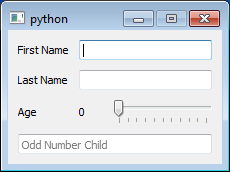An example of the `Form` widget.
A `Form` is a simple subclass of `Container` which automatically lays
out it children in two columns, neatly aligning the widget edges. If
a `Form` has an odd number of children, the last child will span both
columns. The typical use case of a `Form` alternates `Label` and `Field`
instances, but there is not restriction on the types of children used
with a form, except that they be constrainable.
#------------------------------------------------------------------------------
# Copyright (c) 2013, Nucleic Development Team.
#
# Distributed under the terms of the Modified BSD License.
#
# The full license is in the file COPYING.txt, distributed with this software.
#------------------------------------------------------------------------------
""" An example of the `Form` widget.
A `Form` is a simple subclass of `Container` which automatically lays
out it children in two columns, neatly aligning the widget edges. If
a `Form` has an odd number of children, the last child will span both
columns. The typical use case of a `Form` alternates `Label` and `Field`
instances, but there is not restriction on the types of children used
with a form, except that they be constrainable.
<< autodoc-me >>
"""
from enaml.layout.api import hbox
from enaml.widgets.api import Window, Form, Container, Label, Slider, Field
enamldef Main(Window):
Form:
Label:
text = 'First Name'
Field:
pass
Label:
text = 'Last Name'
Field:
pass
Label:
text = 'Age'
Container:
padding = 0
constraints = [
hbox(lbl, sldr),
lbl.v_center == sldr.v_center,
]
Label: lbl:
text << '%d' % sldr.value
constraints = [width == 25]
Slider: sldr:
pass
Field:
placeholder = 'Odd Number Child'
